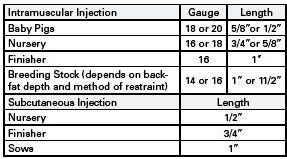Originally published as a National Pork Board Factsheet.

Subcutaneous (SQ): Deposits the Drug Under the Skin
- Inject only into clean, dry areas.
- Use the loose flaps of skin in the flank and elbow of small pigs.
- Use the loose skin behind the ear of sows.
- Slide needle under the skin away from the site of skin puncture before depositing the compound.
Intramuscular (IM): Deposits the Drug Into the Muscle
- Use a spot on the neck just behind and below the ear.
- The neck area should be used for IM injections. (See area outlined in figure to the right.)
- Damage to the ham or loin can result in condemnation of the meat cut.
- Use proper needle size to ensure medication is deposited in the muscle.
Intraperitoneal (IP)
Should be used only upon veterinary instruction and guidance as serious injury to abdominal organs can occur.
Correct Injection Techniques
- Ensure proper restraint of the animal prior toinjection.
- Ensure proper syringe adjustment.
- Ensure proper needle placement onto the syringe.
- Prevent swelling and/or abscessation at the injection site by:
- Using sterile needles.
- Injecting only into clean and dry areas.
- Preventing contamination—don’t use the same needle to inject pigs and remove product from multidose vials.
Consult with your veterinarian about potential adverse drug and vaccine reactions.
Needle Usage Guidelines
1. Correct needle use is not an option – it is a necessity. 2. Change the needle regularly.
- A sharp needle minimizes tissue damage.
- A sharp needle assists in delivering the product into the right site in the muscle or under the skin.
- To protect yourself and others, safely remove and properly dispose of used needles.
- Promptly get medical attention if accidental self-injection occurs.
3. Under normal use, a needle shaft will not break but
- If a needle bends during use, discard it.
- Never use a needle that has been bent and restraightened.
4. If a needle breaks and you can’t retrieve it, mark or identify the pig.
- Check with your packer about their policy for identifying and handling a pig that may have a physical hazard like a broken needle in its muscle.
Keep Accurate Records
Accurate records are essential to using animal health products like antibiotics correctly and judiciously. Judicious Use Guidelines (JUGs) and the PORK QUALITY ASSURANCETM Program say written records of all treatments should:
- Be kept for at least 12 months following the marketing of the medicated animal
- Be used to evaluate the success of a treatment regimen and should include:
- identity of the animal(s) medicated
- date(s) of treatment
- name of medication administered
- who administered the medication
- amount of medication administered
- withdrawal time prior to slaughter
- name of the veterinarian giving directions, if use is other than what is indicated on the label
Intramuscular Injection Gauge Length Baby Pigs 18 or 20 5/8”or 1/2” Nursery 16 or 18 3/4”or 5/8” Finisher 16 1” Breeding Stock (depends on back-fat depth and method of restraint) 14 or 16 1” or 11/2” Subcutaneous Injection Length Nursery 1/2” Finisher 3/4” Sows 1”


